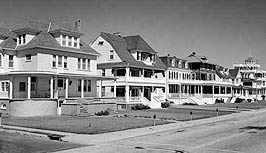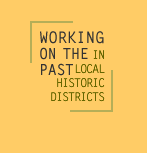 |
||||||





Q. Can my State Historic Preservation Office give financial and other assistance to us while we’re trying to create a historic district?
A. Yes, it can. Through technical assistance and matching grants, the SHPO helps communities build successful preservation programs to protect historic buildings, structures, and archaeological sites.
Preservation Planning
| EXAMPLE | |
| FAQ's
About Local Historic Districts >> South Carolina SHPO [PDF*] |
|
| *Requires Adobe Acrobat Reader |
With preservation planning, communities integrate preservation into other plans and policies, such as transportation, subdivision regulations, housing and economic development. The development or update of a local comprehensive or master plan is a great opportunity to consider the future of a community’s historic resources.
Created with citizen input, a preservation
plan:
• Reviews the current inventory and conditions of historic resources
• Describes the desired future for these resources
• Outlines action steps
Communities may apply for matching grants from the SHPO for preservation planning. Some states may provide planning grants for comprehensive plans that include historic properties.
Surveys of Historic and Prehistoric Resources
Surveys help local governments and preservation groups identify and evaluate historic properties. This information helps communities plan how to protect and benefit from historic and cultural resources.
A survey:
• Identifies historic buildings, structures, and landscapes, and
archaeological sites
• Records physical characteristics and locations on maps
• Evaluates significance in local and State history
• Determines if properties or areas are eligible for listing in
the National Register of Historic Places.
Local governments and non-profit organizations may apply for matching grants from the SHPO to conduct surveys. The SHPO also helps plan and administer surveys. The local government—and the SHPO—keeps completed survey records for future research and planning needs, including GIS systems (Geographic Information System).
Zoning Ordinances
For many states, state law allows communities to adopt and enact zoning ordinances that protect historic and architecturally valuable districts and neighborhoods by restricting or placing conditions on exterior alterations, additions, demolitions or relocations of structures in those areas. Studies across the nation have shown that having local preservation overlay zoning in place not only protects the historic properties, it protects the value of those properties. Thus owners of historic buildings in these protected districts see the value of their investments increase.
Preservation Ordinance. A preservation ordinance protects historic properties by officially recognizing historic areas, buildings and sites as local historic districts and landmarks. Owners of these locally designated properties get approval from a locally appointed board for exterior changes, additions, new construction, relocation or demolition, so that changes complement the historic appearance of the building and its surroundings. This approval process is called design review.
Communities may apply for matching grants from the SHPO to develop or revise a preservation ordinance. Many SHPOs have a sample preservation ordinance and staff will review drafts. The SHPO offers training for members and staff of historic preservation commissions and architectural review boards and responds to special information requests.
Design Guidelines
Design guidelines are both written and graphic advice for preservation commissions and property owners to use when considering the appropriateness of exterior alterations, additions, demolitions, and new construction for local historic districts. Design guidelines are key support materials for administering the preservation overlay zoning ordinance. Guidelines may also be created and used on a voluntary basis, before local historic districts and design review are in place.
Communities may apply for matching grants from the SHPO to create or update design guidelines, which give property owners and historic preservation commissions and design review boards guidance on alterations and new designs that are appropriate for the local historic properties and districts.
Check it out! Another great source
of information for local preservation programs is the
National
Alliance of Preservation Commissions—America's membership organization
for persons and organizations seeking to promote the activities of preservation
commissions.
---------------------------------